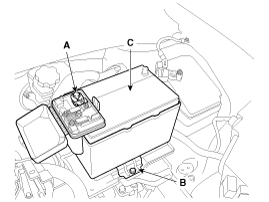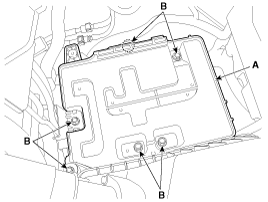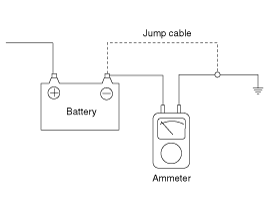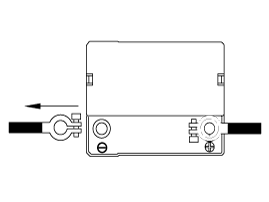Hyundai Tucson: Charging System / Battery Repair procedures
Hyundai Tucson (LM) 2010-2015 Service Manual / Engine Electrical System / Charging System / Battery Repair procedures
| Adjustment |
| Battery charging |
In general, vehicle battery charging system has three forms.
| 1. |
Constant current charge: The battery voltage gradually rises
by charging with setting a constant current. If charging current and
time are not managed correctly, the battery is over-charged, therefore
charging should be stopped after confirming the completion of charging.
|
| 2. |
Constant voltage charge: The battery charge current is gradually reduced by charging with setting a constant voltage. |
| 3. |
Constant current-Constant voltage charge: Charging with constant current and voltage to protect the battery damage
|
| Removal |
| 1. |
Turn the ignition switch OFF and disconnect the battery negative (-) cable. |
| 2. |
Disconnect the positive (+) terminals (A) from the battery. |
| 3. |
Remove the battery insulation pad. |
| 4. |
Remove the battery mounting bracket (B) by loosening the mounting bolt and then remove the battery (C).
|
| 5. |
Remove the ECM. (Refer to Engine Control/Fuel System - "Engine Control Module (ECM)") |
| 6. |
Remove the battery tray (A) after removing the bolts (B).
|
| Installation |
| 1. |
Install in the reverse order of removal.
|
| Vehicle parasitic current inspection |
| 1. |
Turn the all electric devices OFF, and then turn the ignition switch OFF. |
| 2. |
Close all doors except the engine hood, and then lock all doors.
|
| 3. |
Wait a few minutes until the vehicle’s electrical systems go to sleep mode.
|
| 4. |
Connect an ammeter in series between the battery (-) terminal
and the ground cable, and then disconnect the clamp from the battery
(-) terminal slowly.
|
| 5. |
Read the current value of the ammeter.
|
| Cleaning |
| 1. |
Make sure the ignition switch and all accessories are in the OFF position. |
| 2. |
Disconnect the battery cables (negative first). |
| 3. |
Remove the battery from the vehicle.
|
| 4. |
Inspect the battery tray for damage caused by the loss of
electrolyte. If acid damage is present, it will be necessary to clean
the area with a solution of clean warm water and baking soda. Scrub the
area with a stiff brush and wipe off with a cloth moistened with
baking soda and water. |
| 5. |
Clean the top of the battery with the same solution as described above. |
| 6. |
Inspect the battery case and cover for cracks. If cracks are present, the battery must be replaced. |
| 7. |
Clean the battery posts with a suitable battery post tool. |
| 8. |
Clean the inside surface of the terminal clamps with a
suitable battery cleaning tool. Replace damaged or frayed cables and
broken terminal clamps. |
| 9. |
Install the battery in the vehicle. |
| 10. |
Connect the cable terminals to the battery post, making sure tops of the terminals are flush with the tops of the posts . |
| 11. |
Tighten the terminal nuts securely. |
| 12. |
Coat all connections with light mineral grease after tightening.
|
 Battery Components and Components Location
Battery Components and Components Location
Components
1. Battery insulation pad2. Battery3. Battery tray4. Battery mounting bracket
...
 Battery Troubleshooting
Battery Troubleshooting
Troubleshooting
...
Other information:
Hyundai Tucson (LM) 2010-2015 Owners Manual: Display Settings
Press the key
Select [Display] through
TUNE knob or
key
Select menu through
TUNE knob
Mode Pop up
[Mode Pop up] Changes
/
selection mode
During On state, press the or
key to display the mode change pop
up screen.
Text Scroll
[Text ...
Hyundai Tucson (LM) 2010-2015 Owners Manual: Charging system warning light
This warning light indicates a malfunction of either the generator or electrical
charging system.
If the warning light comes on while the vehicle is in motion:
1. Drive to the nearest safe location.
2. With the engine off, check the generator drive belt for looseness or breakage.
3. If the b ...
© 2010-2025 www.htmanual.net






